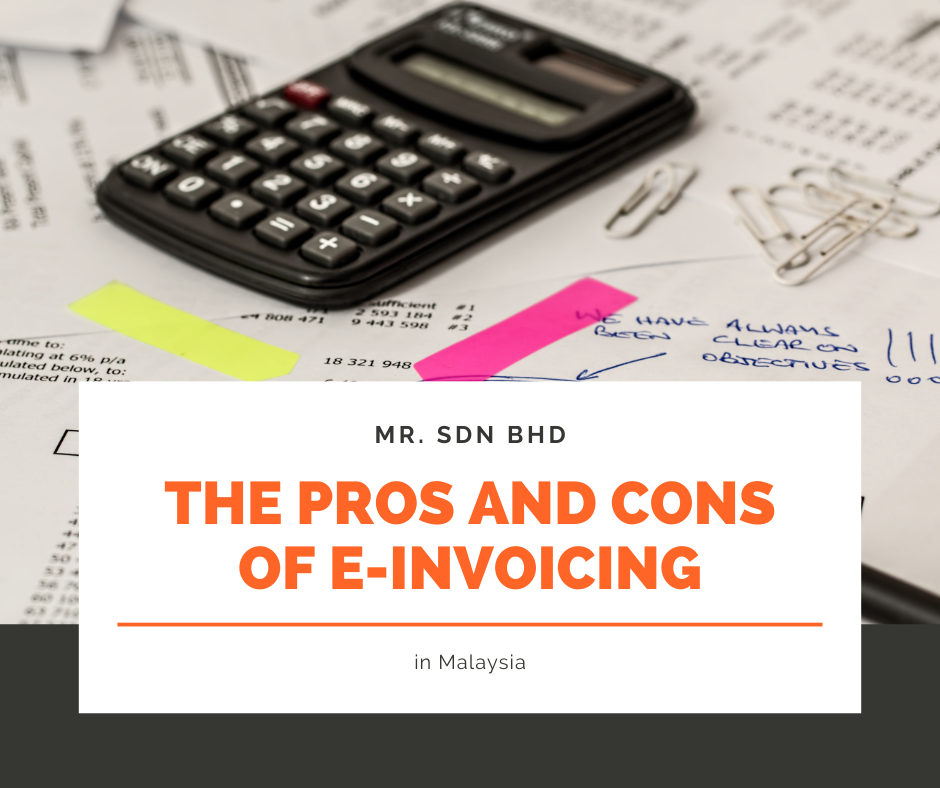
- June 2, 2024
- mrsdnbhd.com
- 0
E-invoicing, the electronic delivery of invoices, is becoming increasingly popular in Malaysia. As businesses continue to digitize their operations, understanding the benefits and drawbacks of e-invoicing is essential. Here’s a look at the pros and cons of adopting e-invoicing in Malaysia.
Pros of E-Invoicing
1. Cost Savings
- Reduction in Paper and Postage Costs: E-invoicing eliminates the need for physical paper and postage, leading to significant cost savings.
- Lower Processing Costs: Automated invoice processing reduces the labor and time required to handle invoices manually.
2. Improved Efficiency
- Faster Processing: E-invoices can be sent and received instantly, speeding up the invoicing process.
- Reduced Errors: Automation minimizes human errors associated with manual data entry.

3. Better Cash Flow Management
- Timely Payments: Faster invoice processing leads to quicker payments, improving cash flow.
- Enhanced Tracking: E-invoicing systems often include tracking features that help monitor the status of invoices.
4. Environmental Benefits
- Reduced Paper Usage: Moving to electronic invoices helps reduce the environmental impact by cutting down on paper use.
- Lower Carbon Footprint: Decreasing the need for physical delivery reduces carbon emissions.
5. Regulatory Compliance
- Adherence to Standards: E-invoicing solutions are designed to comply with local regulations, ensuring that businesses meet all legal requirements.
- Improved Record-Keeping: Electronic records are easier to store and retrieve, aiding in regulatory compliance.
Cons of E-Invoicing
1. Initial Setup Costs
- Investment in Technology: Implementing an e-invoicing system requires an initial investment in software and possibly hardware.
- Training: Employees need to be trained to use the new system effectively.
2. Technical Issues
- System Downtime: Like any digital system, e-invoicing platforms can experience downtime or technical glitches.
- Integration Challenges: Integrating e-invoicing with existing systems can be complex and time-consuming.
3. Security Concerns
- Data Privacy: Storing and transmitting invoices electronically raises concerns about data privacy and protection.
- Cybersecurity Risks: E-invoicing systems can be targets for cyberattacks, requiring robust security measures.
4. Adoption Resistance
- Change Management: Employees and partners accustomed to traditional invoicing methods may resist the change.
- Standardization Issues: Variations in e-invoicing standards can complicate implementation, especially when dealing with international partners.
5. Legal and Compliance Challenges
- Constant Updates: Keeping up with evolving regulations and ensuring ongoing compliance can be challenging.
- Cross-Border Transactions: Different countries have different regulations, which can complicate international invoicing.
Conclusion
E-invoicing in Malaysia offers numerous advantages, from cost savings and efficiency improvements to environmental benefits and regulatory compliance. However, businesses must also consider the initial setup costs, potential technical issues, security concerns, and the challenges of adoption. Weighing these pros and cons will help organizations make informed decisions about implementing e-invoicing in their operations.
